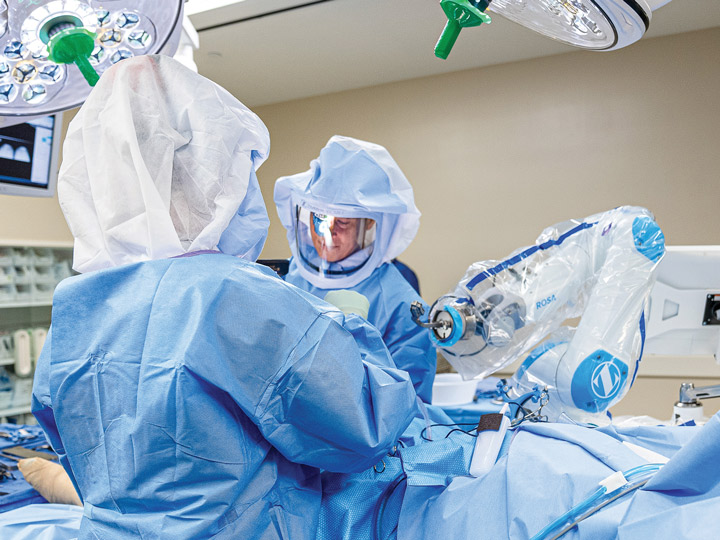- Home
- Article
Your Total Joints Equipment Playbook
By: Carina Stanton | OSM Contributor
Published: 6/24/2025
Where to start? Keep these purchasing considerations in mind.
A successful total joints program requires careful attention to many aspects of care, from preoperative optimization to postoperative pain management — but the actual equipment a surgeon uses for the replacement, including the implant itself, plays a decisive role in patient outcomes.
Investing in your future
If surgeons are willing, centers should consider investing in robots to meet the demands of their current and future caseloads, according to Jesse Hixson, MSN, RN, CNOR, administrator at Allegheny Health Network Monroeville (Pa.) Surgery Center, where more than 200 total joint atthroplasties (TJAs) are performed each year. About 60% of its TJA cases will be performed with robotic assistance in the near future, he says.
The popularity of robotic systems for total knee arthroplasties (TKAs) is surging. They were used in 13% of all TKA cases, according to a September 2024 article in The Journal of Bone and Joint Surgery that cites data from the American Joint Replacement Registry 2023 Report. That level of usage represents a threefold increase from the group’s 2018 report.
Meanwhile, the TJA market is increasing overall. For example, a 2023 JBJS article projects that total hip arthroplasties (THAs) will increase 176% by 2040 and 659% by 2060, while TKAs will increase 139% by 2040 and 469% by 2060. Advances in robotic shoulder and ankle replacements are also gaining traction, and the market trend toward elective orthopedic procedures of all kinds moving to outpatient is not slowing down.
Are robots a fit?
This demand is being driven by patients as well as surgeons who find robots enhance their technique. However, just because nationwide interest in robotic surgery is a reality doesn’t mean every center can benefit from purchasing one. Determine if the demand is there. Will the robot attract new high-volume joint surgeons to your center? Research whether patients in your area are seeking out robotic procedures. If so, then begin the process of getting surgeons to agree on which make and model to buy.
“Robotic platforms can have significant upfront costs, and per-procedure costs for line items such as disposables and maintenance, so you need a high volume to justify the investment, or a contract with the robot manufacturer that addresses these costs,” says Mr. Hixson.
Pre-purchase research should also include learning the exact reimbursement rates for robotic procedures in your area, as they vary across the country. Mr. Hixson says payment rates for robotic surgeries are generally about the same as those for non-robotic ones. Marketing costs for reaching out to patients and prospective new surgeons about the new robot should also be factored into your return-on-investment calculus.
Make sure your instrument sets are high-quality and versatile. “These are the foundation of any successful total joint program,” says Mr. Hixson. Focus on durable instruments that can be used for a range of approaches and invest in enough sets to minimize turnover times between cases. Work with vendors to make loaner trays size-specific to your cases. This cuts costs, prevents wasting sterile processing techs’ time and expedites room turnovers.
Invest in reliable power equipment — and get a service contract. Mr. Hixson offsets the cost of the service contract by bundling multiple pieces of other equipment from the same vendor.

Patient demand for robotic-assisted total joint arthroplasty (TJA) is a key factor in projecting procedural volume to justify the capital expense of a robot. However, patients’ understanding of the benefits and details surrounding a robotic approach aren’t always communicated.
Increased patient education and communication combined with targeted marketing may be needed, based on findings from a February 2025 study that surveyed approximately 500 TJA patients before or after surgery to assess their expectations of robotic technology.
Instead of demonstrating a clear demand for a robotic-assisted TJA surgery, the study found many patients were skeptical about the benefits of the approach.
The authors suggest these tactics to ensure patients better understand what robotic-assisted surgery actually is:
• Define “robotic”. Surgeons may want to discuss the fundamentals with patients because 45% of the patients in the study didn’t even know that robotic surgery is a minimally invasive surgical technique.
• Identify all benefits. Pinpoint the advantages of a robotic platform for surgeons to point out to patients, given that 69.1% of surveyed patients were unsure of the benefits of robotic-assisted TJA, and just 19.5% of patients felt a robotic approach was superior to manual TJA surgery.
Overall, surveyed patients did not believe there were increased benefits of a robotic approach for TJA when compared to non-robotic surgery. While more than two-thirds of those surveyed had heard of robotic surgery, very few sought out surgeons based on their ability to perform robotic TJA.
The study authors suggested more targeted patient education could help patients understand how their long-term surgical goals could be met when choosing a robotic platform for total joints.
—Carina Stanton
A specialized anterior approach table is a must-have if your hip surgeons employ that technique. These tables facilitate controlled leg positioning for femoral exposure. Opt for one that allows for easy patient loading and unloading and make sure it’s compatible with your OR space and imaging equipment.
“Appropriate HVAC, temperature and humidity settings and monitoring are also needed to reduce the risk of infection. Because of the risk of periprosthetic joint infection in TJA, always consider how to mitigate pathogen exposure in your OR through multiple exposure points, including air and personnel. This starts with appropriate ventilation in the OR that is updated as needed for compliance and monitored regularly.
Appropriate protection equipment for surgical staff to wear during TJA procedures can include helmets and full body suits based on staff preference, safety concerns and cost.
Items such as knee positioners and proper bed pads should always be available. They should be used in a standardized fashion and staff must learn to use them properly before they are introduced. Get assurance from vendors that they are compatible with the surgical tables you use.
Dealing with vendors

Trialing equipment that surgeons don’t like is a waste of time, so ask what they prefer in advance. “In other words, don’t invest in equipment that surgeons won’t use,” says Mr. Hixson. Start by thoroughly understanding surgeons’ preferred implants, surgical techniques and equipment preferences.
Bundled purchases can be especially beneficial for robotics packages. Negotiate a comprehensive package that accounts for the robot, initial instrumentation and training. Make sure to discuss detailed service and maintenance agreements that factor in the cost of preventative maintenance and repairs when evaluating equipment. Don’t forget the ongoing costs of consumables such as saw blades, burrs and robotic disposables.
Leasing may be a good option for expensive equipment such as a robot to reduce upfront costs and mitigate the risk of obsolescence. Purchasing may make sense for basic instrumentation where the cost can be amortized over many years. Talk to other orthopedic surgery centers that have invested in a robot. “Ask about their experiences, challenges and lessons learned,” says Mr. Hixson. Approach interactions with vendors with long-term relationships in mind. Be transparent with them about your budget, volume projections and strategic goals. Choose vendors that are committed to providing ongoing support, training and technical assistance. Partner with them for help in forecasting your needs and estimating your surgical volume to know how much instrumentation and other equipment to buy. Have them help you track your usage to predict when buying replacements will be necessary. OSM
.svg?sfvrsn=be606e78_3)
.svg?sfvrsn=56b2f850_5)